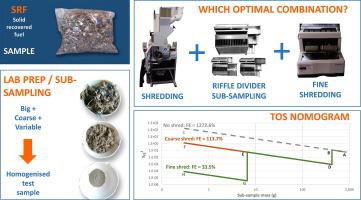Waste Management ( IF 7.1 ) Pub Date : 2020-06-28 , DOI: 10.1016/j.wasman.2020.06.010 Spyridoula Gerassimidou 1 , Costas A Velis 1 , Dimitrios Komilis 2

|
The uncertainty arising from laboratory sampling (sub-sampling) can compromise the accuracy of analytical results in highly inherent heterogeneous materials, such as solid waste. Here, we aim at advancing our fundamental understanding on the possibility for relatively unbiased, yet affordable and practicable sub-sampling, benefiting from state of the art equipment, theoretical calculations by the theory of sampling (ToS) and implementation of best sub-sampling practices. Solid recovered fuel (SRF) was selected as a case of a solid waste sample with intermediate heterogeneity and chlorine (Cl) as an analyte with intermediate variability amongst waste properties. ToS nomographs were constructed for different sample preparation scenarios presenting the trend of uncertainty during sub-sampling. Nomographs showed that primary shredding (final d90 ≤ 0.4 cm) can reduce the uncertainty 11 times compared to an unshredded final sub-sample (d ≈ 3 cm), whereas cryogenic shredding in the final sub-sample can decrease the uncertainty more than three times compared to primary shredding (final d90 ≤ 0.015 cm). Practices that can introduce bias during sub-sampling, such as mass loss, moisture loss and insufficient Cl recovery were negligible. Experimental results indicated a substantial possibility to obtain a representative final sub-sample (uncertainty ≤ 15%) with the established sub-sampling plan (57–93%, with 95% confidence), although this possibility can be considerably improved by drawing two final sub-samples instead (91–98%, with 95% confidence). The applicability of ToS formula in waste-derived materials has to be investigated: theoretical ToS calculations assume a poorer performance of the sub-sampling plan than evidenced by the experimental results.
中文翻译:

建立源自废物的固体回收燃料(SRF)的子采样计划:切碎对基于采样理论(ToS)的代表性样品制备的影响。
实验室采样(子采样)带来的不确定性可能会损害诸如固体废物等高度固有的异质材料中分析结果的准确性。在这里,我们的目标是增进对以下方面的基本理解:相对无偏,可负担且可行的子采样,得益于先进的设备,通过采样理论(ToS)进行的理论计算以及最佳子采样实践的实施。选择固体回收燃料(SRF)作为具有中等异质性的固体废物样品,并选择氯(Cl)作为废物性质之间具有中等可变性的分析物。为不同的样品制备方案构建了ToS nomograph,在二次采样期间呈现不确定性趋势。Nomographs显示主要碎纸(最终d90 ≤0.4厘米)可以减少不确定性的11倍相比,unshredded最后的子样本(d≈3cm)中,而最后的子样品在低温粉碎可以减少不确定性的三倍以上相比初级碎纸(最终d 90 ≤0.015厘米)。在子采样过程中可能引起偏差的做法,例如质量损失,水分损失和氯离子回收不足,可以忽略不计。实验结果表明,通过既定的二次抽样计划(57-93%,置信度为95%),可以得到具有代表性的最终子样本(不确定度≤15%),尽管通过绘制两个最终样本可以大大改善这种可能性。而是使用子样本(91–98%,置信度为95%)。ToS公式在废物衍生材料中的适用性必须进行研究:理论上的ToS计算假设子采样计划的性能比实验结果证明的要差。











































 京公网安备 11010802027423号
京公网安备 11010802027423号